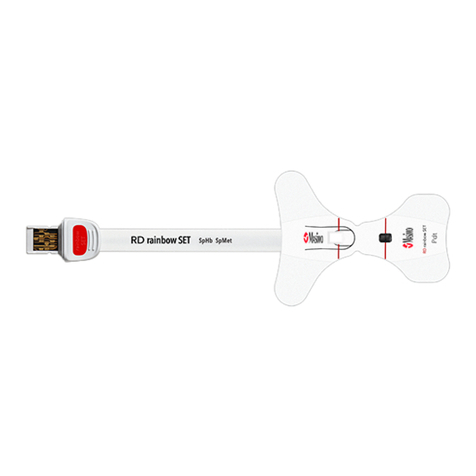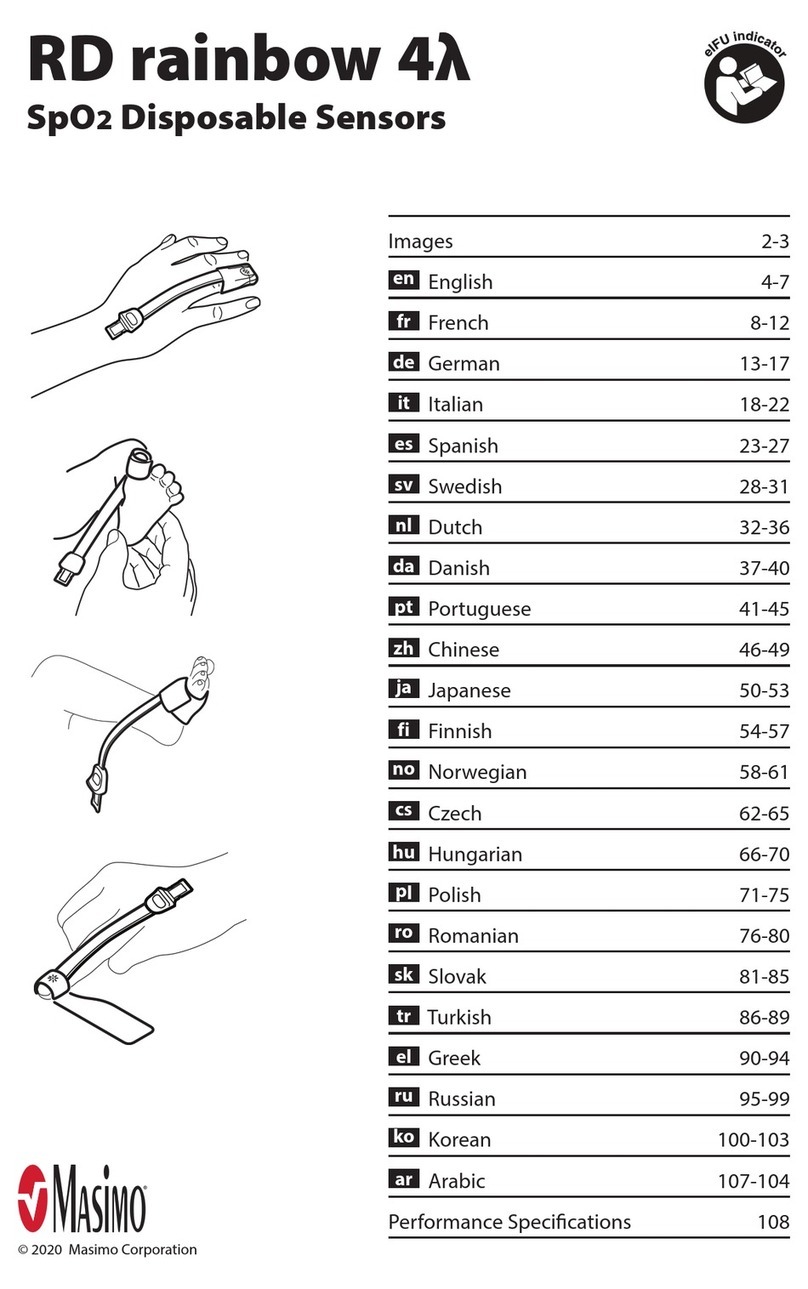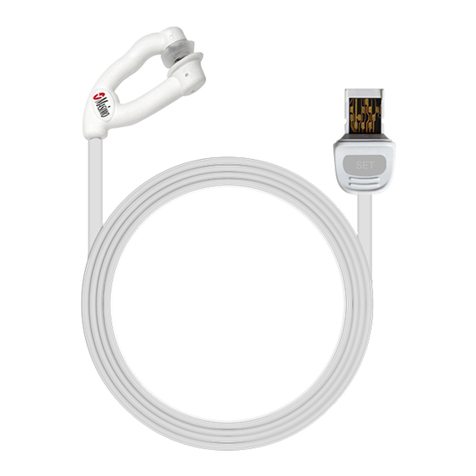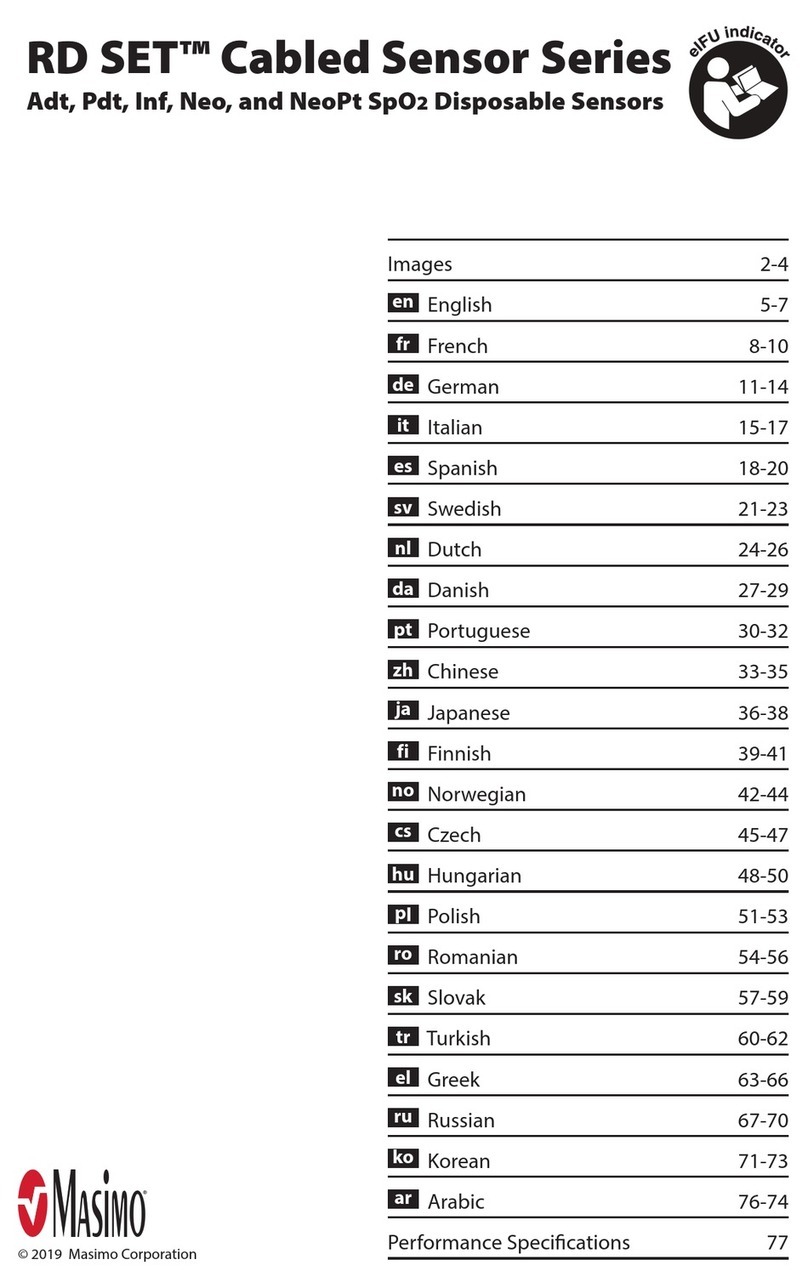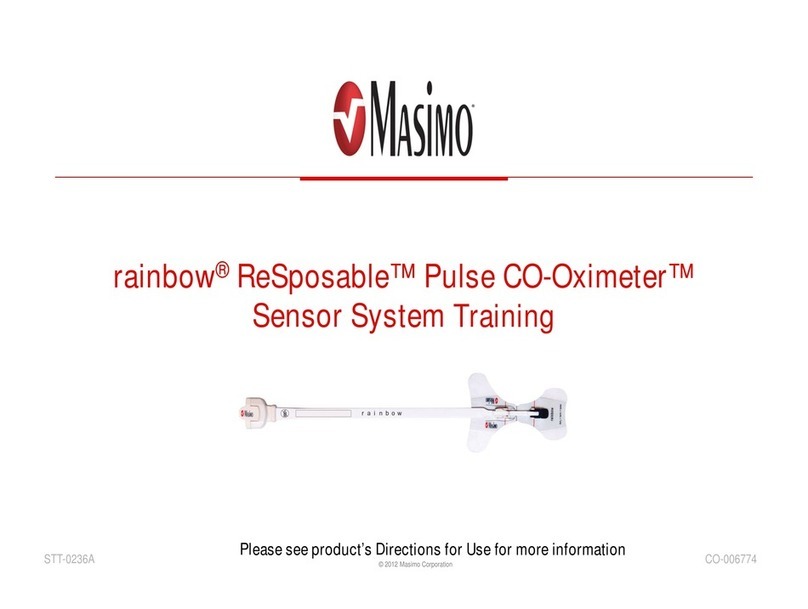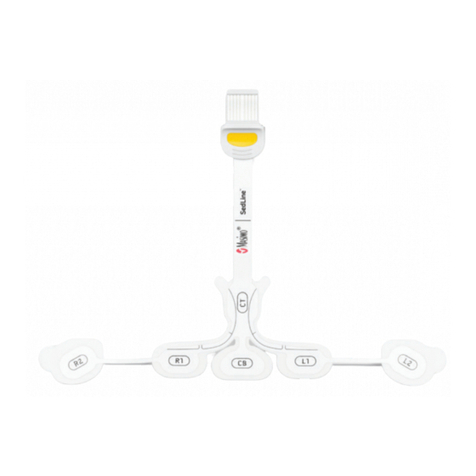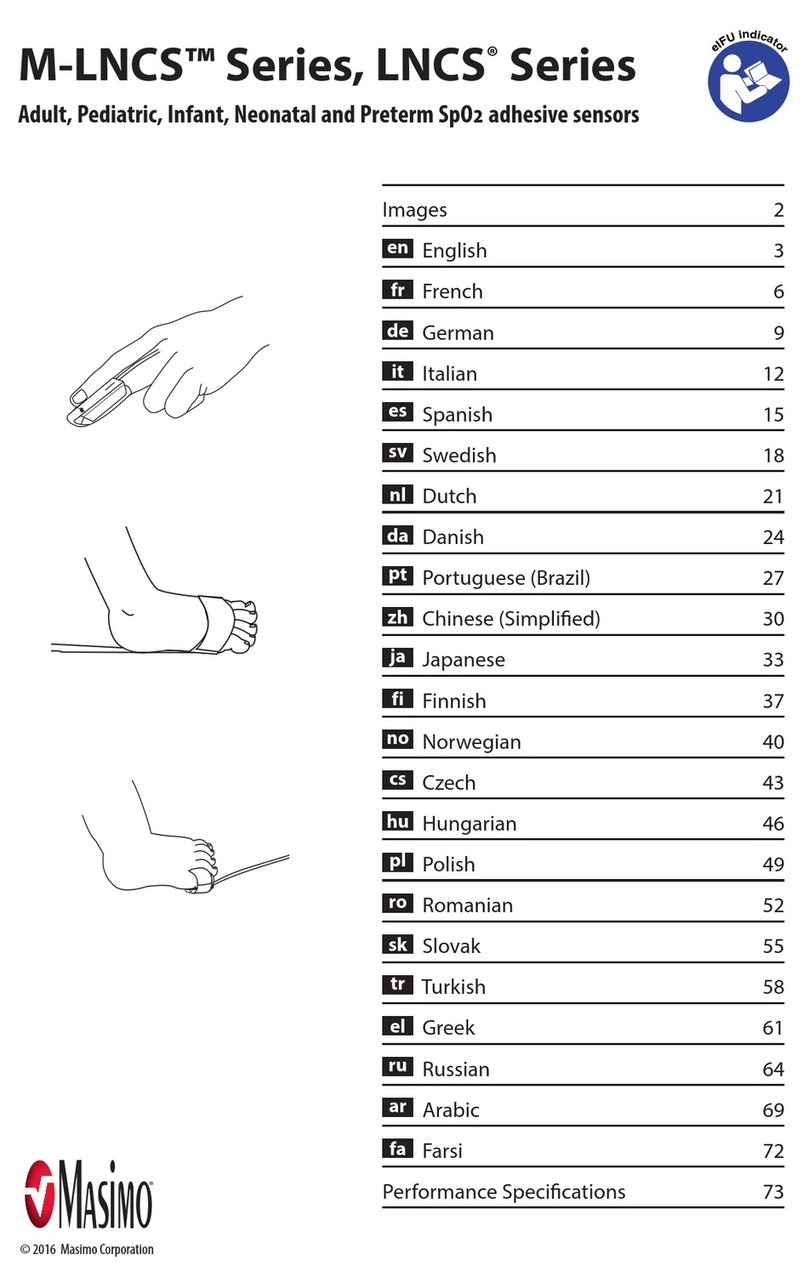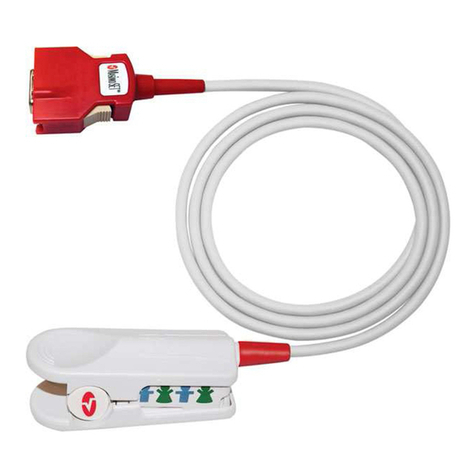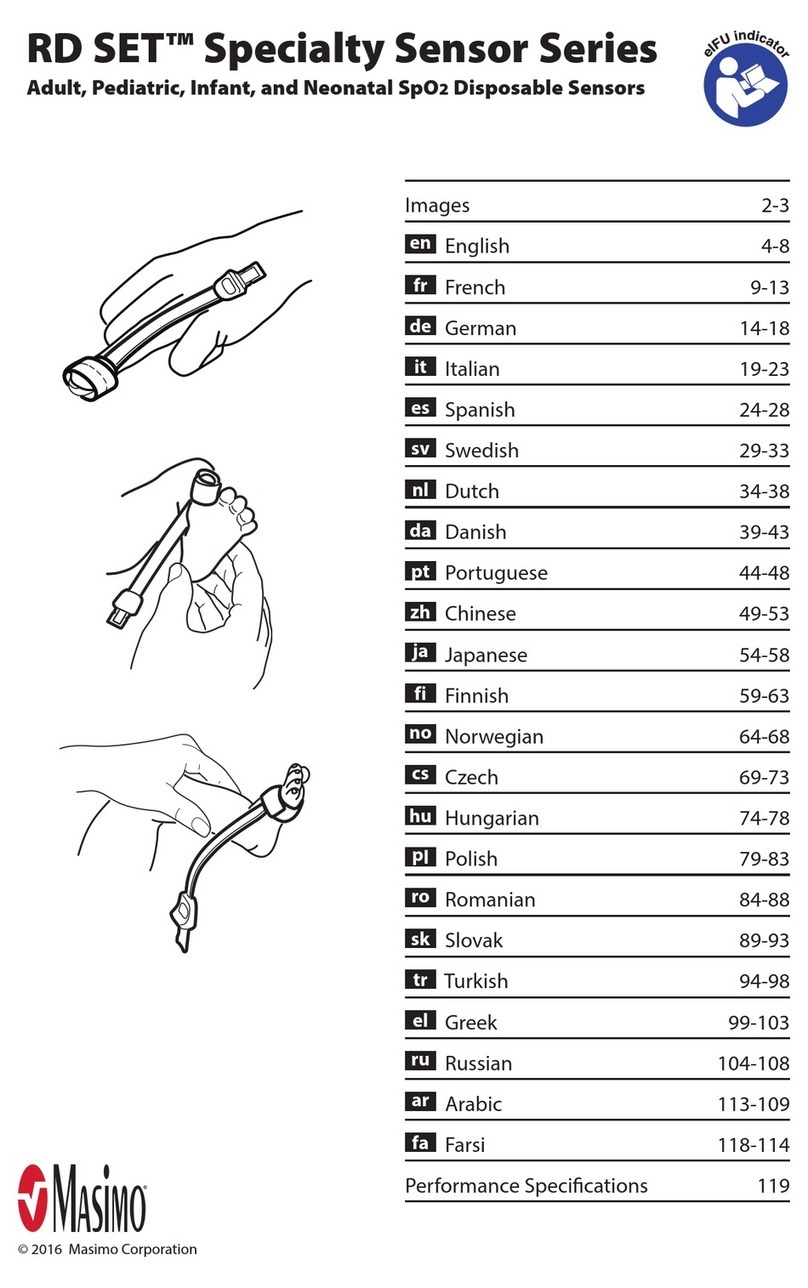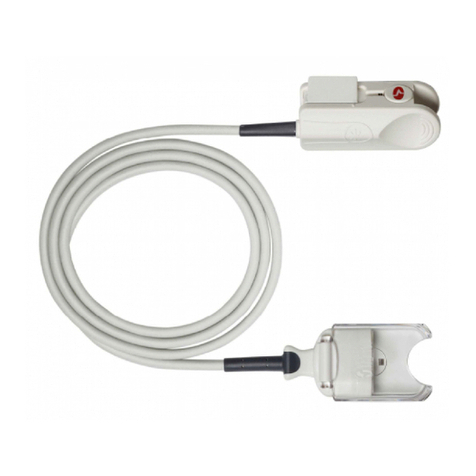
79022B-eIFU-0119
RD SET™ DBI
Capteurs souples réutilisables
MODE D’EMPLOI
Réutilisable
LATEX
Ne contient pas de latex naturel
NON
STERILE
LATEX
Title:Graphics, Sensor/Cable symbols, 03/06
GR-14231
DRO-13914
-40 C
+70 C
+1060 hPa - +500 hPa
795 mmHg - 375 mmHg
5%-95% RH
5%
95%
%
Non stérile
Avant d’utiliser ce capteur, l’utilisateur doit lire et comprendre le Manuel de l’opérateur du moniteur et ce mode d’emploi.
INDICATIONS
Dans le cadre d’une utilisation avec Masimo SET® ou Masimo rainbow® SET:
Les capteurs souples réutilisables RD SET™ DBI sont indiqués pour la surveillance continue et non invasive ainsi que la vérication ponctuelle de
la saturation fonctionnelle en oxygène de l’hémoglobine artérielle (SpO2) et de la fréquence du pouls (mesurée à l’aide d’un capteur SpO2) chez
les adultes et les enfants au repos, ainsi que chez les patients ayant une bonne ou une mauvaise perfusion dans les hôpitaux, les installations de
type hospitalier, mobiles et à domicile.
Dans le cadre d´une utilisation avec les oxymètres de pouls Nellcor et compatibles Nellcor, ou avec la technologie Philips FAST SpO2:
Les capteurs souples réutilisables RD SET DBI sont indiqués pour la surveillance continue et non invasive ainsi que la vérication ponctuelle de la
saturation fonctionnelle en oxygène de l’hémoglobine artérielle (SpO2) et de la fréquence du pouls (mesurée à l’aide d’un capteur SpO2) chez les
patients au repos, et dans les hôpitaux, les installations de type hospitalier, mobiles et à domicile.
CONTRE-INDICATIONS
Les capteurs souples réutilisables RD SET DBI ne doivent pas être utilisés sur des patients mobiles ni pour une durée prolongée. Le site du capteur
doit être inspecté au moins toutes les quatre (4) heures, ou plus fréquemment si nécessaire, et si les conditions de circulation ou l’intégrité cutanée
sont compromises, le capteur doit être appliqué sur un site diérent.
DESCRIPTION
Les capteurs souples réutilisables RD SET DBI ne doivent être utilisés qu’avec des appareils contenant la technologie Masimo SET ou autorisés
à l’utiliser. Pour plus d’informations sur la compatibilité d’un appareil spécique et de modèles de capteur, consulter le fabricant d’appareils.
Chaque fabricant d’appareils doit déterminer si ses appareils sont compatibles avec chaque modèle de capteur.
Les capteurs à usage unique RD SET DBI ont été vériés avec la technologie Masimo rainbow SET™.
Les capteurs RD SET DBI ont été vériés sur les oxymètres de pouls Nellcor N-200 et N-395.
AVERTISSEMENT : les capteurs et câbles Masimo sont conçus pour être utilisés avec des appareils équipés de l’oxymètre Masimo SET®, ou
autorisés à utiliser des capteurs Masimo.
AVERTISSEMENTS, MISES EN GARDE ET REMARQUES
• Tous les capteurs et les câbles sont conçus pour être utilisés avec des moniteurs spécifiques. Vérifier la compatibilité du moniteur, du câble
et du capteur avant de les utiliser, afin d’éviter toute dégradation des performances et/ou blessure éventuelle du patient.
• Le capteur ne doit présenter ni défauts visibles, ni traces de décoloration, ni dommages. Si le capteur est décoloré ou endommagé, arrêter
immédiatement de l’utiliser. Ne jamais utiliser de capteur endommagé ou de capteur dont un composant électrique est accessible.
• Le site doit être contrôlé fréquemment ou selon le protocole clinique afin d’assurer une circulation adéquate, de maintenir l’intégrité de la
peau et de corriger l’alignement optique.
• Procéder avec précaution; si le capteur n’est pas régulièrement déplacé, est trop serré, ou devient trop serré à cause d’un œdème, une
érosion cutanée, une ischémie tissulaire et/ou une nécrose due à la pression peuvent apparaître. Inspecter le site toutes les heures et
déplacer le capteur en présence de signes d’ischémie tissulaire et/ou de perte de circulation ou de perfusion.
• Ne pas utiliser de bande adhésive pour fixer le capteur sur le site; cela risque de restreindre le flux sanguin et de provoquer des erreurs de
lecture. L’utilisation de bande adhésive peut provoquer une lésion cutanée et/ou une nécrose de pression ou détériorer le capteur.
• Positionner le capteur et le câble patient de façon à réduire les risques d’enchevêtrement ou de strangulation.
• Un capteur mal positionné ou déplacé est susceptible d’entraîner des erreurs de mesure.
• Les mauvaises utilisations dues à des types de capteur incorrects peuvent entraîner des mesures imprécises ou l’absence totale de mesure.
• Des mesures inexactes de la SpO2peuvent être causées par une pulsation ou une congestion veineuse anormale.
• En cas de congestion veineuse, la valeur mesurée de la saturation du sang artériel en oxygène risque d’être inférieure à la valeur réelle.Veiller
à assurer un débit veineux correct au niveau du site de mesure. Le capteur ne doit pas être placé sous le niveau du cœur (par exemple,
capteur sur la main d’un patient alité dont le bras pend au sol).
• Les pulsations veineuses peuvent générer de fausses mesures de SpO2faible (par exemple, régurgitation tricuspidienne, position de
Trendelenburg).
• Les pulsations d’un ballon de support intra-aortique peuvent affecter la fréquence du pouls affichée sur l’oxymètre. Comparer la fréquence
du pouls du patient à la fréquence cardiaque de l’ECG.
• Éviter de placer le capteur sur une extrémité dotée d’un cathéter artériel ou d’un brassard de pression non invasive.
• En cas d’utilisation de l’oxymétrie du pouls pendant une exposition du corps entier aux rayonnements, maintenir le capteur hors du champ
d’irradiation. Si le capteur est exposé aux rayonnements, la mesure peut être inexacte ou absente pendant la durée de l’irradiation active.
• En cas d’utilisation de l’oxymétrie du pouls pendant une exposition du corps entier aux rayonnements, maintenir le capteur hors du champ
d’irradiation. Si le capteur est exposé aux rayonnements, la mesure peut être inexacte ou égale à zéro pendant la durée de l’irradiation active.
• Ne pas utiliser le capteur pendant un examen IRM ou dans un environnement IRM.
• Des sources d’éclairage ambiant de forte intensité telles que des lampes chirurgicales (plus particulièrement celles au xénon), des lampes
à bilirubine, des éclairages fluorescents, des lampes de chauffage à infrarouge ou une exposition directe au soleil peuvent interférer avec
les performances du capteur.
• Afin d’éviter les interférences de la lumière ambiante, vérifier que le capteur est correctement appliqué et recouvrir le site du capteur avec
un matériau opaque, si nécessaire. L’utilisation du capteur sous une lumière trop vive peut donner lieu à des erreurs de mesure.
• Des perturbations électromagnétiques peuvent provoquer des mesures inexactes.
• Des doigts présentant des lésions, des marqueurs intravasculaires, notamment du vert d’indocyanine ou du bleu de méthylène, ou des
colorants et textures externes (tels que du vernis à ongles, des ongles en acrylique, des paillettes, etc.) sont susceptibles d’entraîner des
erreurs ou l’absence de mesure.
fr

